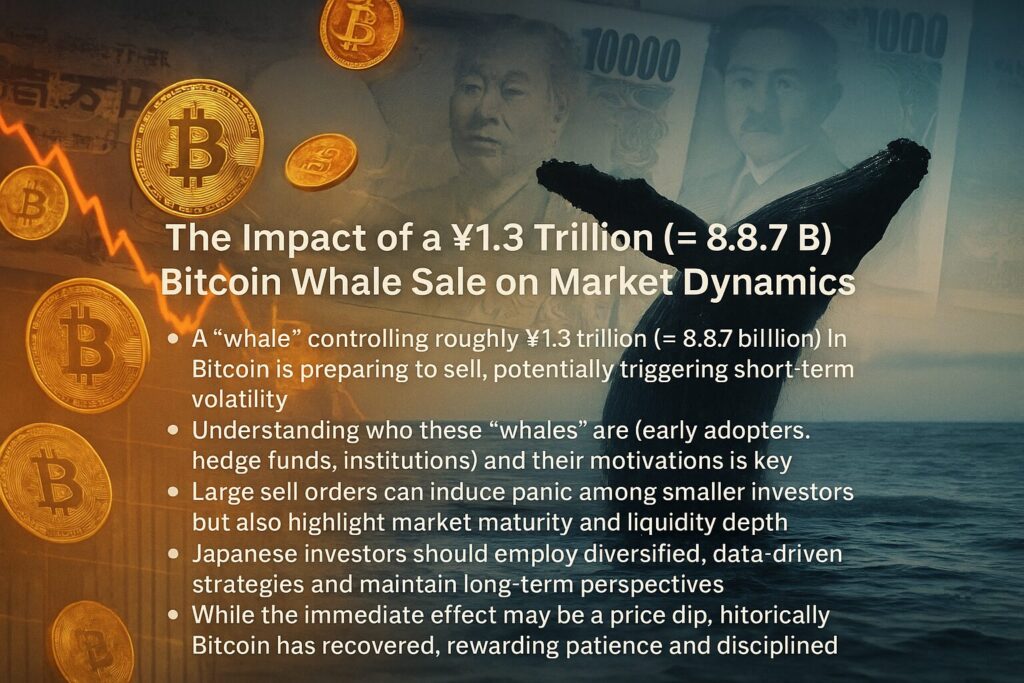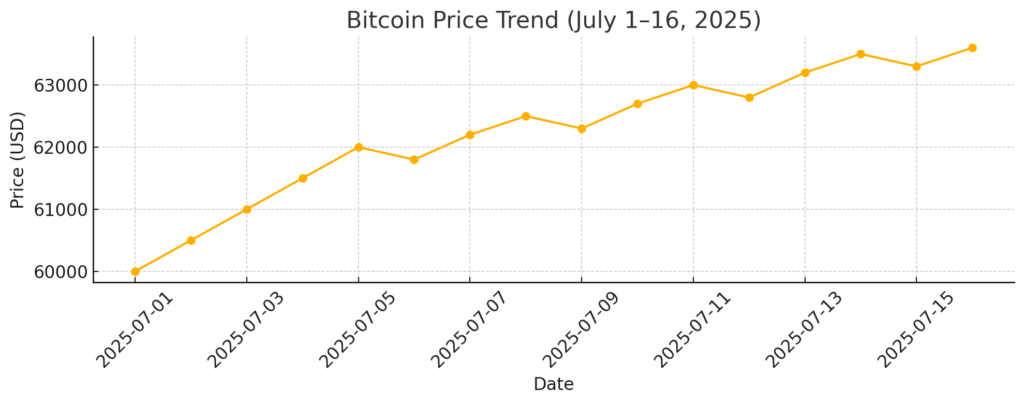
Main Points:
- A “whale” controlling roughly ¥1.3 trillion (≈ $8.7 billion) in Bitcoin is preparing to sell, potentially triggering short‑term volatility.
- Understanding who these “whales” are (early adopters, hedge funds, institutions) and their motivations is key.
- Large sell orders can induce panic among smaller investors but also highlight market maturity and liquidity depth.
- Japanese investors should employ diversified, data‑driven strategies and maintain long‑term perspectives.
- While the immediate effect may be a price dip, historically Bitcoin has recovered, rewarding patience and disciplined risk management.
1. Prelude to the Drop: Signs of a ¥1.3 Trillion Whale Preparing to Sell
Recent on‑chain analytics firms have flagged an unusually large accumulation address moving nearly ¥1.3 trillion worth of BTC onto exchange wallets. At current exchange rates (¥150 = $1), this equates to roughly $8.7 billion. Such a transfer is a strong signal that an entity—often dubbed a “whale”—intends to liquidate its holdings on centralized exchanges. This comes at a time when Bitcoin has steadily climbed from around $60,000 on July 1 to $63,600 by July 16 (see Fig. 1). A sudden influx of supply at these levels could outpace immediate buy orders, leading to a rapid price correction.

Whales typically choose to offload via major exchanges to access deep order books, but this action also sends a psychological signal to the broader market: if a major holder believes the top is near, others might follow suit. Historically, similar whale sales have led to short‑lived dips of 5–10% before stabilization. However, in thinner markets or during low‑volume times, the impact can be magnified.
2. Identifying the “Whale”: Origins and Motivations
Who are these market‑shaking whales? Broadly, they fall into three categories:
- Early Adopters: Individuals or entities mining or purchasing Bitcoin in its early days (2010–2013) who still hold large balances.
- Institutional Investors: Hedge funds, family offices, or public companies that allocated significant capital during the 2020–2022 institutional adoption wave.
- Crypto‑Native Funds: Dedicated crypto hedge funds or trading desks that accumulate on dips to profit from momentum trading.
Their motivations vary:
- Profit‑Taking: Locking in multi‑year gains, especially after Bitcoin’s recent run from $30,000 in December 2024 to over $63,000 in mid‑July 2025.
- Rebalancing Portfolios: Shifting to other asset classes (equities, bonds, altcoins) to diversify or reduce concentration risk.
- Strategic Shifts: Preparing for regulatory developments (e.g., potential U.S. stablecoin regulation under the GENIUS Act) by preserving capital for compliance costs or tax liabilities.
Understanding these drivers helps retail investors interpret whether a whale’s sale reflects a broader market sentiment shift or an idiosyncratic decision.
3. Market Implications: How Massive Sell Orders Influence Price Movements
When a whale dumps billions of dollars’ worth of Bitcoin, the immediate effect is a flood of sell orders hitting the exchange order books. If buy‑side liquidity is insufficient, prices can gap downward. This not only affects the whale’s sale price but also triggers stop‑loss orders and margin liquidations, amplifying the downward spiral.
Psychological Impact
Smaller retail investors often view large on‑chain transfers as bearish signals. Social media chatter spikes with fear‑driven posts, leading to panic selling that can magnify the price drop by an additional 2–3%.
Market Depth and Liquidity
However, Bitcoin’s market has matured significantly. Bitfinex, Binance, and Coinbase collectively show deep books capable of absorbing $1–2 billion without drastic slippage. A single $8.7 billion sell will likely be staggered over several hours or days, mitigating instant crashes. Moreover, algorithmic liquidity providers and market‑making bots adjust their quotes dynamically, cushioning the impact.
Altcoin and Derivatives Ripple Effects
Whale sales often coincide with rotation into altcoins or DeFi tokens. Capital exiting Bitcoin may flow into high‑beta assets like SUI or ETH forks, temporarily boosting their prices. Derivatives markets (futures, options) will see an uptick in implied volatility (skew) and funding rates, reflecting short‑term bearish bets on Bitcoin.
4. Mitigating Risks: Strategies for Investors in a Volatile Crypto Market
In light of whale‑driven volatility, Japanese and global investors should adopt disciplined approaches:
- Diversification
- Allocate across multiple crypto assets and traditional classes (stocks, bonds).
- Consider stablecoins (USDC, USDT) to park profits during high volatility.
- Staggered Entry and Exit
- Use dollar‑cost averaging (DCA) for buys and sells to smooth price extremes.
- Set limit orders at strategic levels (e.g., $62,000, $60,000) rather than market orders.
- On‑Chain and Technical Analysis
- Monitor on‑chain metrics (exchange inflows/outflows, active addresses).
- Combine with chart patterns (support/resistance zones) for confirmation.
- Risk Management Tools
- Employ stop‐loss or take‐profit orders but leave buffers to avoid “whale whipsaw.”
- Use options strategies (protective puts, collars) to cap downside.
- Stay Informed
- Follow credible analytics firms (Glassnode, Kaiko) and regulatory updates (SEC, BIS).
- Subscribe to alerts for large on‑chain transfers or regulatory announcements.
5. Future Outlook: Bitcoin’s Path Beyond the Whale’s Shadow
While a ¥1.3 trillion whale sale may spark a swift correction, Bitcoin’s long‑term fundamentals remain robust:
- Supply Scarcity: The upcoming 2028 halving will further tighten issuance to 3.125 BTC per block.
- Institutional Adoption: Major corporates (Tesla, MicroStrategy) continue to allocate on dips.
- Regulatory Clarity: Potential U.S. stablecoin regulation (GENIUS Act) and EU MiCA framework lend legitimacy to crypto markets.
Even if Bitcoin dips 10–15% in the coming days, historical patterns show rebounds within weeks. Patient investors who view corrections as buying opportunities often outperform those who flee markets in panic.
Conclusion
The revelation of a ¥1.3 trillion (≈ $8.7 billion) Bitcoin whale unloading its holdings underscores both the volatility and maturation of the crypto market. Large sell orders can trigger short‐term price swings, but deep liquidity and algorithmic market makers provide buffers. Japanese investors should resist emotional trading, focus on diversified, data‐driven strategies, and maintain a long‐term horizon. Ultimately, Bitcoin’s finite supply, growing institutional adoption, and evolving regulatory frameworks suggest that corrections—no matter how dramatic—are part of its journey toward mainstream financial integration.

